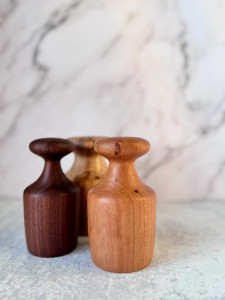
When I was a kid, Mama made biscuits nearly every day. She would mix up the dough the night before and refrigerate it overnight so the dough wasn't too soft when rolling it out the next morning. Her recipe? Mix everything till it "feels right." Yep. That's the secret lol... Mama used her grandma's biscuit cutter, which is a very Southern thing to do. We pass down heirlooms like that, because they mean something to our family. It might just be an old cut out tin can, but it has sentimental value. When we developed our line of wooden biscuit cutters, Mama was hesitant at first, wanting to sit it on the shelf "for looks."
One day, I was there when she was making biscuits and I grabbed the biscuit cutter - hers is Black Walnut - and tossed it in the flour. "It's dirty now; go ahead and use it," I told her. And she did. That's all she's used since. For clarity, my Daddy makes biscuits most of the time now (he gets up earlier) and he uses the biscuit cutter as well. Because, as it turns out, it has become a new family heirloom. Funny how that works.
These biscuit cutters are a great gift for the biscuit maker in your family. And, in the South, there's always one of those. Don't let that Southern talk fool you, biscuits have been on the rise (haha) as of late all over the US. Get a taste of Tennessee at your breakfast table.
All of our wooden kitchenwares are handmade by a small family-owned business in rural Tennessee. It's a learned tradition, handed down from father to son and spans multiple generations. The vast majority of the pieces come from locally-sourced trees (often from my parents' farm).
The Cathead biscuit cutter is, perfect for making breakfast sandwiches, cutting scones, or even pastries for, say, a strawberry shortcake.
Handmade in Tennessee, using staved wood (Black Walnut, Ambrosia Maple, Cherry, White Oak). These make exceptional one-of-a-kind gifts that will eventually become a new family heirloom.
Makes 3" diameter biscuits
* Do not put in the dishwasher. Do not soak in the sink. I recommend wiping with a damp cloth after use. Periodically, if needed, use beeswax or food-safe mineral oil for upkeep.
Featured in Food Network Magazine, Southern Cast Iron Magazine, Taste of the South Magazine, and Southern Living Magazine.









